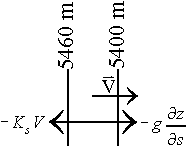

Antitriptic flow is the only balanced flow in the atmosphere that is defined using the s equation of motion, since there cannot be any tangential acceleration to the flow. The following forces are in balance in antitriptic flow:
The pressure gradient: 
 The frictional force:
The frictional force: 
Antitripic flow is the least common of all the balanced flows in the atmosphere, because of the balance of forces that are involved. By the definition of the forces balanced, the flow must be purely cross-contour with frictional effects balancing the cross-contour flow. In addition to that, there must be no coriolis, no pressure gradient with respect to the n axis, no centrifugal force, and no tangential acceleration. This means that the flow has to be either small in scale or near the equator to neglect the effects of the coriolis. The curvature has to be equal to zero as well. Since the likelihood of all these conditions being met is not very real, the possibility of observing true antitriptic flow is minimal. The following graphic illustrates the force balance that is required for antitriptic flow, showing how unlikely it is:

Although the reality of true antitriptic flow is limited, the atmosphere does attempt to simulate it. One atmospheric scenario that supports simulated antitriptic flow is a valley wind. With mountains on either side of the valley, the effects of the coriolis force turning the wind to the right are minimized. Therefore, the flow will flow directly from high to low pressure in the valley, simulating antitriptic flow.
 Next topic: Cyclostrophic flow
Next topic: Cyclostrophic flow
 Previous topic: Balanced Flows
Previous topic: Balanced Flows